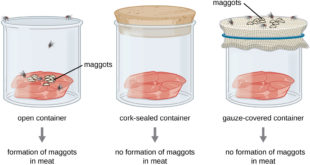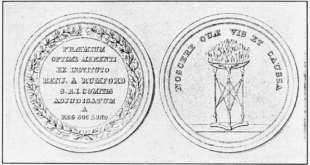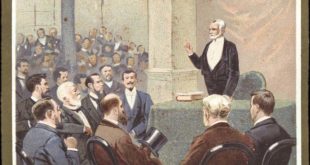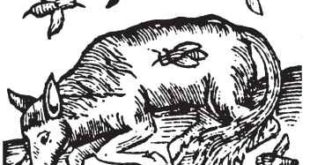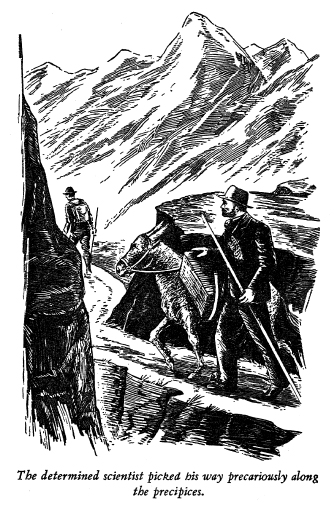
Louis Pasteur delivered a heavy blow to the theory of “spontaneous generation” when his famous experiment displayed that fermentation could be prevented even when a fermentable substance was exposed to the atmosphere. However, the debate continued, the science at hand matured and the discussion became much more involved. Some of the chimerical conceptions of creating mice and scorpions from dirty rags and sunlight slowly developed into more refined scientific theories requiring unique physical experiments.
The Theory of Heterogenesis
One of the newest and most prominent followers of the spontaneous generation theory was Félix Archimède Pouchet, the Director of the Natural History Museum in Rouen. He began presenting papers in 1855 to the Academy of Sciences in Paris and eventually published a large volume in 1859 to the Academy of Medicine entitled, Hétérogénie ou Traité de la generation spontanée. From that point on Pouchet would drop the generic term of spontaneous generation and instead began supporting his theory of “heterogenesis.” Pouchet deeply believed in what he was studying and was determined to bring about physical evidence to support his beliefs. In the preface he clearly stated his position saying, “When I had thought about the matter long enough to become convinced that spontaneous generation is still one of the means that nature uses to reproduce its creatures, I set out to discover which procedures would allow us to bring these phenomena to light.”
This was a bold statement. Pouchet was not only stating that heterogenesis was the production of a new organized being, but that it was a principle of nature itself. He proposed that living organisms are not extracted from raw matter but from the organic particles of earlier generations of animals and plants. He hypothesized that animals are being produced out what he termed “plastic manifestation” that groups molecules of living matter together and imposes upon them a specific vitality that eventually results in a new being. Pouchet stated his theory thus: “Spontaneous generation is the production of a new organized being that lacks parents and all of whose primordial elements have been drawn from ambient matter.”
In a way, Pouchet rearranged existing facts and ideas to fit his theory. At the time of his treatise his ideas were improvable and only that: theories. Pouchet moved to bring forth physical evidence of his theories and because they had not been disproven, it invigorated the discussion once again. The idea that successive generations of life arise as a result of the innate construction of matter and that this construction was provided by nature itself flew in the face of Pasteur’s work on fermentation. Pouchet contested the existence of microorganisms and was on a mission to prove it.
Heterogenesis Experiments
Alongside his Traité, Pouchet published an experiment that directly targeted the work of Pasteur. Not only did Pouchet consistently develop microbes after meticulously following Schwann’s experiments, but by substituting artificial for atmospheric air, he demonstrated that airborne contamination had nothing to do with their proliferation. Pouchet’s experiment was as follows:
He filled a flask with boiling water and closed it hermetically. He then plunged the flask into a mercury trough (used to rapidly cool the flask). Once cooled, he added oxygen and a small bundle of calcined hay (calcination is a thermal treatment process) which consistently resulted in the appearance of a fungi.
These results compelled Pouchet to state that atmospheric air is not and cannot be responsible for the microbes. He concluded that this was a case of spontaneous generation.
This temporarily hushed those at the Academy who were closely following the work of Pasteur and his collaborators. Jean-Baptiste Dumas and Claude Bernard were quick to criticize certain aspects of Pouchet’s work, but neither could provide ample evidence to show the experiments were flawed. It was then that the Academy of Sciences proposed the following topic for the 1862 Alhumbert prize in natural science: “To attempt by means of well-designed experiments to cast new light on the question of so-called spontaneous generations.” A committee was created and composed of Milne-Edwards, Flourens, Brongniart, Serres, and Geoffroy Saint-Hilaire, many of which already openly opposed Pouchet’s theory. Pasteur’s work was in question and now he had an official forum for a response, one that almost seemed to be designed for him, and with a 2,500 franc stipend awarded to the winner, Pasteur had a fortuitous opportunity in front of him: defend and promote his ideas on germ theory, lay to rest the theory of heterogenesis and claim a prize that could fund his laboratory and ongoing research.
Pasteur’s Experiment
Pasteur set out to disprove Pouchet. However, the usual causes of microbial infection had already been negated by Pouchet’s experiment: The oxygen used in the experiment was artificial, the water was heated and placed into the flask while boiling and the hay was heated to 300 degrees. However, Pasteur was already on the case and after examining the experiment with great confidence stated,
“I shall demonstrate that there was one source of error that M. Pouchet did not notice, that never occurred to him, that had never occurred to anyone before him, and that this source of error makes his experiment completely useless, and as bad as that of Van Helmont’s pot of dirty linen. I shall show you where the mice came in. I shall demonstrate that in every experiment of the kind that concerns us here, one must absolutely rule out the use of the mercury trough.”
Pasteur did not want to simply prove that Pouchet was factually wrong, he wanted to assert that spontaneous generation definitively does not exist. He wanted to prove that life was not developing on its own within a sanitized flask. He believed that germs somehow entered the flask during the experiment and survived all existing conditions. To do this, Pasteur would develop a new experimental strategy, which as biographer Patrice Debré stated, “was to remain exemplary for its precision, its chronology, and its inventiveness.” Pasteur’s experiments and principle proof of his objections to Pouchet were published in the form of a Mémoire sur les corpuscules organisés qui existent dans l’atmosphère as well as a lecture and experiments presented at the Sorbonne in 1864.
1. Pasteur demonstrated that microorganisms are in the air.
Pasteur invented an apparatus that was a kind of vacuum tube with a hydraulic mechanism that would pump in the outside air of the rue d’Ulm or garden of the Ecole normale. The air was then filtered through a wad of gun-cotton and later to eliminate criticism of microorganisms living in the cotton fibers, he replaced it with a wad of asbestos. One could then examine the dust caught in the fibers with a wash under the microscope and observe the living microorganisms.
2. Pasteur discovered the source of contamination was in the mercury.
Pasteur was known to be hypercritical when it came to his experiments. He would rarely entrust important procedures to laboratory assistants or even trusted colleagues. He was meticulous and repeated experiments over and over again to ensure consistent results. Because of his precision and skill in the laboratory, Pasteur discovered that particles from the atmosphere proliferate in liquids that serve as a nutrient source, in this case, the mercury. Pasteur shows that germs are not only in the air, but attach themselves to the substances in which they thrive.
3. Pasteur reproduces various microorganisms.
Pasteur showed that heat destroys airborne germs which can reproduce abundantly if given the opportunity. He then commented on his new discovery, “In mercury or other compounds which receive microbial spores, all it takes to propagate this possible source of contamination are the non sterile hands of a careless experimenter.”
4. Pasteur reasserts his position that lack of germs results in sterility of a substance.
Pasteur wanted to show that when experiments are properly carried out and all microorganisms are avoided, a substance will remain sterile. That it is the introduction of microorganisms, already existing life, that causes the reproduction of other living organisms. At the prompting of Balard, Pasteur adopted another experimental model. He created a series of vessels that communicated with the outside air through a glass neck that bent and curved with different forms and lengths. These long necks served to keep the germs from entering into the vessel, showing that the liquids would remain sterile when not exposed to the germs in the air.
This experiment earned Pasteur the Alhumbert Prize but the heterogenesists were still not completely convinced. Although he never challenged Pasteur’s refutation of his experiment’s Pouchet could not concede to Pasteur’s idea that air is the ultimate vehicle for germs. Taking samples from around France, Thebes and even Egypt, Pouchet showed that not all air contains germs. Many of his air samples were sterile themselves. Pasteur was forced to revamp his original argument that “germs are everywhere” to one where the atmosphere’s generative capacity was neither constant nor absolute and that it must vary with the place and season.
Pasteur wanted to show that if a fermentable liquid was exposed to the purest air, no generation of microorganisms would take place. Pouchet and the heterogenesis crowd sought to prove that growth exists in every case, regardless of the quality of air. This would lead Pasteur to the highest mountain tops for science, literally.
 Pasteur Brewing Louis Pasteur – Science, Health, and Brewing
Pasteur Brewing Louis Pasteur – Science, Health, and Brewing 